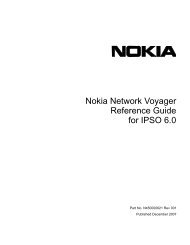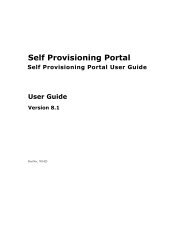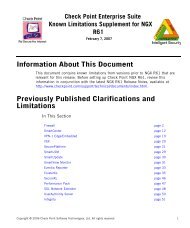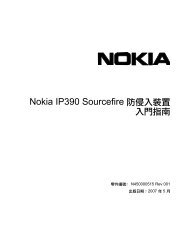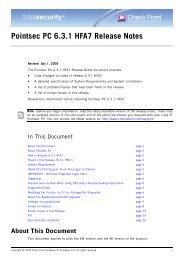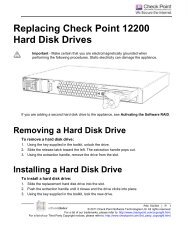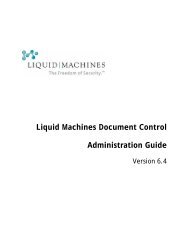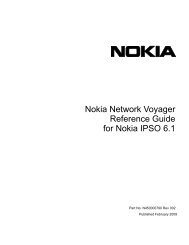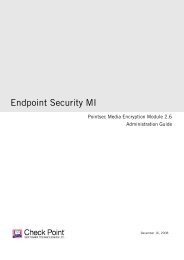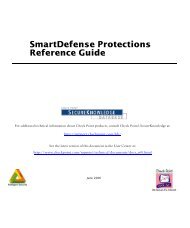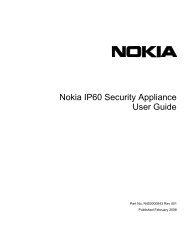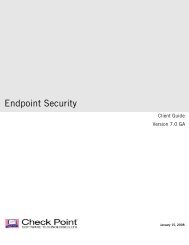NGX R65 Release Notes - Check Point
NGX R65 Release Notes - Check Point
NGX R65 Release Notes - Check Point
Create successful ePaper yourself
Turn your PDF publications into a flip-book with our unique Google optimized e-Paper software.
ClusterXL<br />
member than the client-to-server side. Asymmetric connections are only opened when using<br />
VPN or static NAT. This is a temporary performance degradation that affects only a small<br />
percentage of traffic.<br />
9. When installing a new policy that uses Sticky Decision Function (configured in SmartDashboard<br />
> Cluster Object > ClusterXL page > Advanced), and the old policy used the regular decision<br />
function, some connections may be lost, especially connections to or from the cluster<br />
members. New connections are unaffected.<br />
10. After a failover, non-pivot members of a ClusterXL cluster in Unicast mode may report incorrect<br />
load distribution information. For the correct load distribution, review the information reported<br />
by the pivot member.<br />
11. When using ClusterXL in Load Sharing mode and the Sticky Decision Function is enabled, the<br />
failure of a module within 40 seconds of an IKE negotiation may cause a connectivity failure<br />
with that peer for up to 40 seconds.<br />
• When the failure involves a PIX gateway, communications may be interrupted for up to 40<br />
seconds.<br />
• When the failure involves an L2TP client, communications may be disconnected, as<br />
keepalive packets are blocked during this period.<br />
12. traceroute may fail if it passes through a Load Sharing cluster. To resolve this issue, on the<br />
Cluster object, select ClusterXL > Advanced and in the Advanced Load Sharing Configuration<br />
window you should either:<br />
• select Use Sticky Decision Function, or<br />
• change the selection for Use sharing method based on: to IPs.<br />
Platform Specific — Nokia<br />
13. Either Nokia VRRP or Nokia IP Clustering configuration must be used when creating a cluster<br />
based on an IPSO platform. Using other OPSEC Certified third party clustering products (such<br />
as OPSEC Certified external load balancers) to create a cluster based on IPSO platforms has<br />
limited support. Contact <strong>Check</strong> <strong>Point</strong> Support and receive configuration instruction and a list of<br />
associated limitations.<br />
14. After configuring a gateway cluster on a Nokia platform via the Simple mode (wizard), be sure to<br />
complete the cluster interface definition on the Topology page of the cluster object.<br />
15. The feature Connectivity enhancements for multiple interfaces is not supported on Nokia IP<br />
clustering in Forwarding mode.<br />
16. NAT rules should not be applied to VRRP traffic. To prevent NAT rules from being applied to<br />
VRRP traffic, define the following manual NAT rule and give it higher priority than other NAT<br />
rules that relate to Cluster VIPs or to their networks:<br />
Original Packet Translated Packet Install On<br />
Source Destination Service Source Dest Service<br />
Physical IP of VRRP IP: 224.0.0.18 Any Original Original Original relevant cluster<br />
VRRP members<br />
17. When configuring a Nokia IP Cluster, do not set the primary or secondary interfaces to Network<br />
Objective Private. <strong>Check</strong> <strong>Point</strong> recommends setting a Nokia IP Cluster’s primary interface to<br />
Network Objective Cluster, and its secondary interface to Network Objective Cluster or Sync.<br />
18. The Get Topology operation supports up to 256 interfaces on Nokia platforms. To define more<br />
than 256 interfaces, you need to do so manually.<br />
VPN-1/FireWall-1 <strong>NGX</strong> <strong>R65</strong> Known Limitations Supplement. Last Update — February 4, 2008 5:37 pm 6




